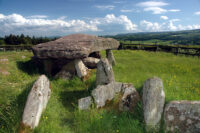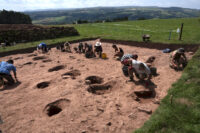 Arthur’s Stone, a Neolithic chambered tomb in Herefordshire which was C.S. Lewis’ inspiration for the “stone table” on which Aslan was sacrificed in The Lion, the Witch, and the Wardrobe, has been discovered to be 5,700 years old, more than a thousand years older than Stonehenge (ca. 2,500 B.C.).
Arthur’s Stone, a Neolithic chambered tomb in Herefordshire which was C.S. Lewis’ inspiration for the “stone table” on which Aslan was sacrificed in The Lion, the Witch, and the Wardrobe, has been discovered to be 5,700 years old, more than a thousand years older than Stonehenge (ca. 2,500 B.C.).
The burial got its name in the Middle Ages (before the 13th century) when all sorts of random monuments were given made-up associations with King Arthur. The legend assigned to this one was that here Arthur killed a giant who fell on one of the stones embedding his elbow prints into it.
Today Arthur’s Stone is a massive capstone weighing an estimated 25 tons supported by nine upright standing stones. It was once covered by a long, oval earthen mound that was accessible via a right-angled passage into a smaller inner chamber of the barrow. Archaeologists have long believed the tomb was part of wedge-shaped cairn.
 Despite its cultural prominence as a national landmark, Arthur’s Stone was never professionally excavated and centuries of interference from antiquarians, stone harvesters and road construction made it challenging to determine its original structure, purpose and date. Archaeologists from the Universities of Manchester and Cardiff excavated the barrow for the first time this year.
Despite its cultural prominence as a national landmark, Arthur’s Stone was never professionally excavated and centuries of interference from antiquarians, stone harvesters and road construction made it challenging to determine its original structure, purpose and date. Archaeologists from the Universities of Manchester and Cardiff excavated the barrow for the first time this year.
They found that the tomb had first been a long mound composed of stacked turf, retained by a palisade of upright posts set in a narrow palisade surrounding the mound. However, when the posts rotted away and the mound had collapsed, an avenue of larger posts were added, leading toward the mound from the Golden Valley below.
The initial mound, identifiable in the palisade slot and the parch-marks visible from the air surrounding the stone chambers, points toward the nearby hilltop of Dorstone Hill.
However the later avenue of posts, together with the two stone chambers and an upright stone located immediately in front of them, align on the far horizon in the gap between Skirrid and Garway Hill to the south-east.
“The different orientations of the two phase of construction are significant because our excavations on Dorstone Hill in 2011-19 revealed three long mounds similar in construction to that now known to represent the first stage of Arthur’s Stone,” added [University of Manchester] Professor [Julian] Thomas.
“Each of these three turf mounds had been built on the footprint of a large timber building that had been deliberately burnt down. So Arthur’s Stone has now been identified as being closely connected with these nearby ‘halls of the dead’, which hit the headlines in 2013.
“Indeed, the block of upland between the Golden Valley and the Wye Valley is now becoming revealed as hosting an integrated Neolithic ceremonial landscape.”